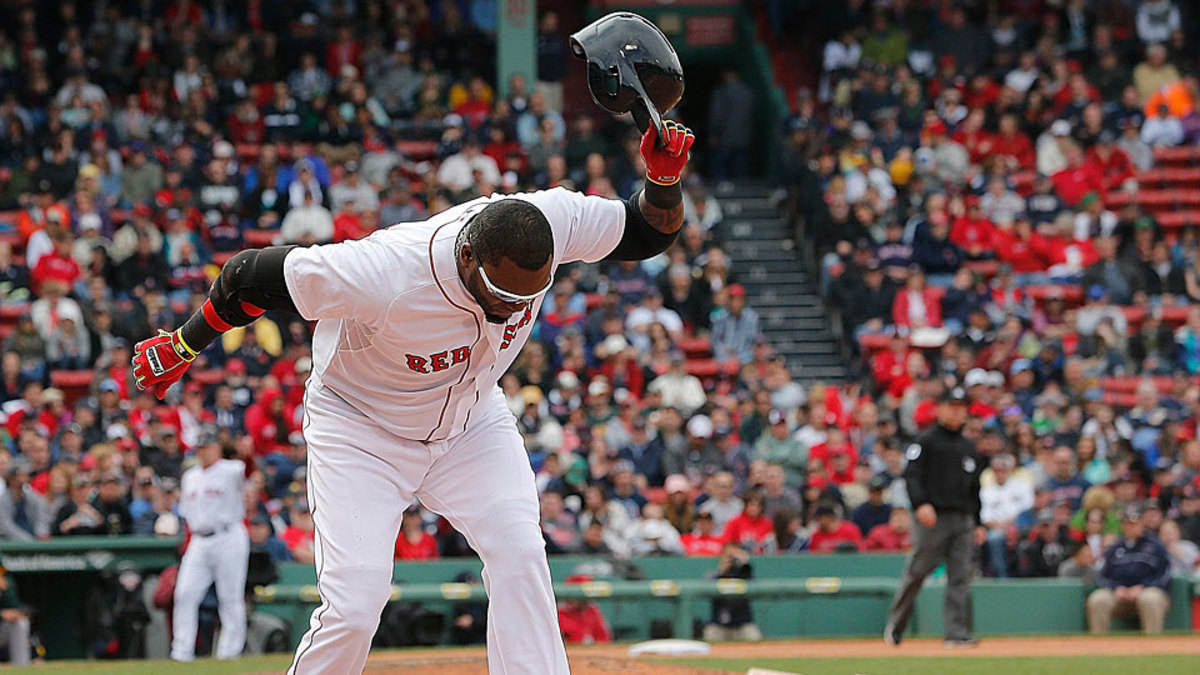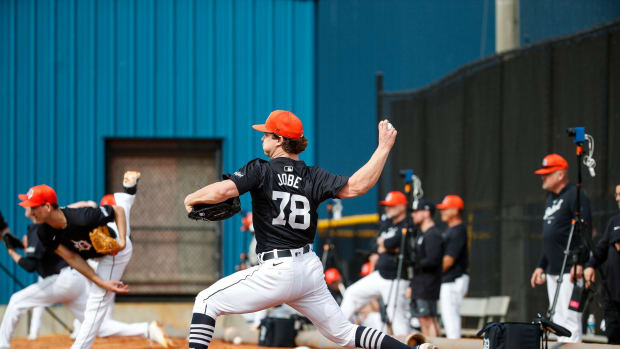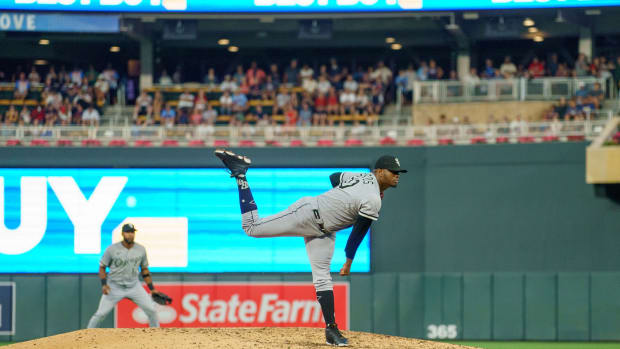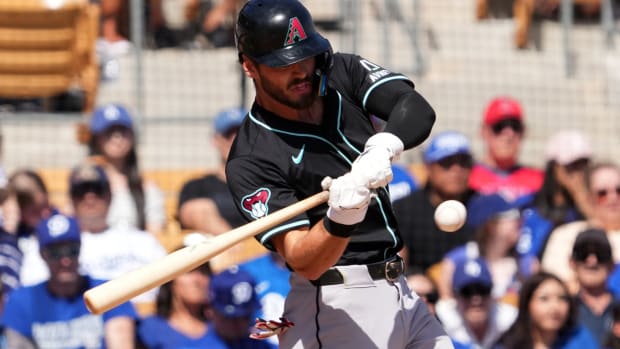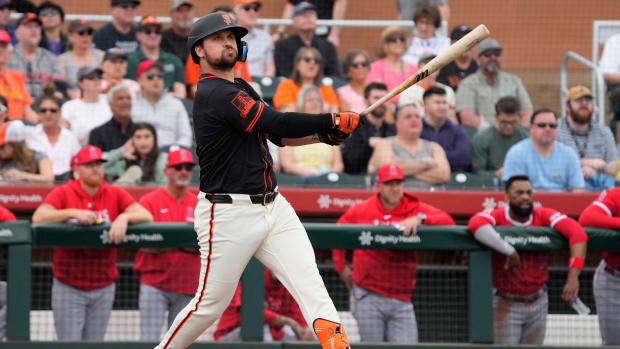As shifts suppress offense, time has come to consider a rule change
Parity and Pitching; that is the headline to the story of the 2014 season. With 60 percent of the season played, 16 teams remain within three games of a playoff spot. The run-starved environment has helped narrow the gap between the good teams and the bad teams.
If hitting is reduced simply to who wins the one-on-one battle between the batter and the pitcher – whether the batter gets on base or not, as recorded by on-base percentage – it never has been worse since the designated hitter was introduced in 1973. But there is a third element to the batter vs. pitcher fight that is draining offense from the game: defense. The shifting of defenders out of their traditional positions is adding to the hitters’ difficulty.
“I liked it better when people thought we were the crazy ones,” said Tampa Bay manager Joe Maddon, whose team was an early adapter with defensive shifts. “Now everybody is doing it.”
I recently asked a veteran major league hitting coach what can be done to inject more offense back in the game. His first response was to address the new defensive positioning.
“The shifts,” he said. “Get rid of them. You need to come up with a definition of illegal defense. I know you’ll say, ‘Well, you’re a hitting coach. Of course you would [say that].’ But it’s something that has really changed the game.”
Support of an “illegal defense” rule – or at least the consideration of it – is gaining some traction in baseball. Such a rule might stipulate, for instance, that you cannot have three infielders on one side of second base. A shortstop would be able to shift as far as directly behind second base on a lefthanded hitter, but no farther.
MLB Power Rankings: Braves make a move, might need to consider another
Is it time for such a rule? My gut reaction is that it is time to at least think about it. All-fields hitting needs to increase. But Maddon, himself a former hitting instructor, believes that it will take years for the counter-response to make an impact. He said the emphasis on using the whole field to hit must begin with organizational teaching in the low minors. “You can’t make the same impact with guys already at the major league level,” he said.
So you may be talking about three years or more before you start seeing real change. Can baseball keep selling such a low-scoring, low-activity environment in the meantime?
Teams have figured out not just where hitters are most likely to hit the ball, but also that the second baseman should not be stationed so close to the first baseman, as he was for the past 100 years or more. It’s not just that a shortstop or third baseman is shifted to the right side against lefthanded hitters; it’s that the second baseman often can play a deep rover-type position in rightfield – it’s a matter of logic that the second baseman can play as far away from the first baseman as does the third baseman. More depth means more range, which means fewer chances for a hit to a hitter’s preferred field.
Because the inverse does not hold true – you can’t put the shortstop in short leftfield because the throw is too long – shifts are killing one type of hitter in particular: the lefthanded pull hitter with little speed. The most obvious example this year is Chris Davis of Baltimore. He hit .402 last year on balls in play to the pull field. This year, with shifts against him becoming more frequent and extreme, he is hitting .186 on balls in play when he pulls them.
In fact, many lefthanded sluggers are having down years. The group includes Davis (.202 batting average overall), Ryan Howard (.222), Jay Bruce (.221), Adam Dunn (.223), Shin-Soo Choo (.239), Pedro Alvarez (.237), Brian McCann (.242), David Ortiz (.251) and Adrian Gonzalez (.256).
Is it all due to the shift? Of course not. Well-known factors such as increased velocity from pitchers; the popularity of the two seamer/cutter combination; the winking acceptance of substances such as lotion and pine tar to help spin the ball; and the depth of bullpens have helped make hitting harder than at any time in the DH era. But the shift is another major factor in taking hits away from lefthanded batters, especially as the shift has become universally popular over the past three or four years.
Check this out: here are the batting averages over the past 10 seasons when lefties pull the ball (which includes home runs) and when they pull the ball in play (Batting Average on Balls in Play removes the home runs):
Year | Batting Average | BABIP |
2005 | .431 | .379 |
2006 | .436 | .386 |
2007 | .401 | .353 |
2008 | .410 | .358 |
2009 | .401 | .350 |
2010 | .399 | .351 |
2011 | .378 | .332 |
2012 | .364 | .313 |
2013 | .373 | .323 |
2014 | .349 | .301 |
Look at that steep decline, especially this year, as everybody gets on board with shifting. Lefthanded hitters have lost 22 points on their batting average on balls in play to rightfield this year alone – and 85 points in nine years.
Here’s another way to examine what the shift is doing to lefthanded hitters. In 2010, Howard, McCann, Ortiz, Bruce, Dunn, Choo, Curtis Granderson and Adam LaRoche all were among the best lefthanded hitters in the game. None of them were All-Stars this year. Fewer hits to the pull field – into the shift – is one reason. Throw in former All-Stars Mark Teixeira and Carlos Beltran, two more slow-footed sluggers (and using only their numbers batting lefthanded), and you can see how the shift is harming lefthanders, though at least two sluggers beat the trend:
player | 2010 | 2014 | Difference |
Carlos Beltran | .354 | .171 | -.183 |
Shin-Soo Choo | .384 | .222 | -.162 |
Jay Bruce | .404 | .302 | -.104 |
Mark Teixeira | .346 | .246 | -.100 |
Curtis Granderson | .375 | .276 | -.099 |
Ryan Howard | .364 | .207 | -.097 |
Brian McCann | .324 | .239 | -.085 |
Adam Dunn | .353 | .288 | -.065 |
Adam LaRoche | .393 | .343 | -.050 |
David Ortiz | .257 | .230 | -.027 |
.474 | .564 | +.090 | |
Adrian Gonzalez | .279 | .306 | +.027 |
(The above chart gives you a hint at the Yankees’ troubles. They were starved for lefthanded power after last season, but Teixeira, Beltran and McCann all are pull-happy hitters from the left side without speed who are harmed by increased shifts. New York's BABIP is the third-worst in the American League.)
Poor guys. It’s as if the rules of baseball changed on them in mid-career. One day they can ground singles past the second baseman with ease; the next they look up from the batter’s box at a Maginot Line in which hard-hit balls become outs in short rightfield.
Did you watch the All-Star Game? There was a noticeable lack of extreme shifts. Why? Yes, an All-Star team isn’t going to deploy the same depth of analytics that one particular team would, but the truth is very few extreme pull hitters were selected as All-Stars. None of the 12 pull-hitting former All-Stars on the above list were selected to the game this year. It’s hard to post a high batting average when you use half the field and the defense has that half so well covered.
The shift is driving to extinction the lefthanded .300 hitter with power. In 1999, 13 lefthanded hitters batted at least .300 with 25 home runs. This year, there is only one such hitter on that pace (the Indians' Michael Brantley). Including 2014's projection, only six times has a lefthanded hitter batted .300 with 25 homers over the past three seasons; in the three seasons at the height of The Steroid Era (1999-2001) it happened 33 times.
You don’t need to introduce the Steroid Factor to see the decline. Over the past 20 years, three of the worst seasons for such all-around lefthanded hitters have occurred in each of the past three years. Below are the seasons with the fewest lefthanded hitters to bat .300 with 25 home runs, starting in 1994:
1 (tie). 2007, 2014*: 1
3 (tie). 2008, 2012: 2
5. 2013: 3
*Projected
The inverse to the extinction of the all-around lefthanded hitter is the increase in the lefthanded power hitter who can’t hit for average. The recent wholesale adoption of the shift is helping create more low-average lefthanded power hitters than ever before. Take a look at the seasons with the most lefthanded batters to bat .250 or worse with 15 home runs in the Modern Era (1901-2014):
1. 2009, 2012: 14
2. 2013, 2014*: 13
3. 2002: 12
4. 2008: 10
*Projected
David Ortiz passes Carl Yastrzemski on MLB's all-time home run list
The player who best represents how shifts make life miserable for lefthanded hitters is Ortiz. Back in 2004, when shifts were rare, the Boston designated hitter had 48 singles to the pull field, including 19 on groundballs. This year he has only 13 singles to rightfield, including only five groundballs that managed to penetrate the Maginot Line. If you trace the popularity of shifts against Ortiz to 2008, when Maddon’s shift-happy Rays won the American League pennant and helped hold him to a .154 average in the ALCS, you get an idea of what the shift has done to Ortiz. The table below charts his BABIP to rightfield based on the number of at-bats and hits that ended with the ball going to that same field, but not counting home runs:
Years | At-Bats | Hits | BABIP |
1997-2007 | 925 | 328 | .355 |
2008-2014 | 716 | 188 | .263 |
The difference in BABIP amounts to 66 hits lost since 2008 just to rightfield. Give him another 66 hits, and his lifetime average would rise from .285 to .294. An oversimplification? Yes, sure. But you get the point: hitting has never been this hard since 1972, and lefthanded hitters without speed are harmed more than anybody because of the shifts. In 10 years we have lost 1,219 hits a season just by lefthanded hitters to rightfield.
Is it time for an illegal defense rule? We can all sit here and pretend nothing is wrong and count on the natural “ebbs and flows” of the game to self-correct the decline in offense. Or we can do what the lords of baseball have done many times when offense was down, such as outlawing the spitball and putting a clean baseball in play (1920), lowering the mound (1969) and introducing the DH (1973): we can update the rules.
Now, pace of game is a bigger problem than lack of offense and should be addressed first and easily; you could cut almost 30 minutes of dead time tomorrow simply by refusing to let players dawdle. Put the same amount of offense in a two-and-a-half hour package as opposed to a three-hour package and lack of offense is a smaller issue. But if baseball isn’t going to address pace of play, then you should be concerned about where offense is and where the trendlines say it is going. In just nine years (all with steroid testing) lefthanded batters have lost 85 points off their batting average when they pull the ball. That is staggering. It’s easy to see what shifts are helping to do to the game. It’s not so easy to decide if something needs to be done about it.






























